BUICK PARK AVENUE 1998 Owners Manual
Manufacturer: BUICK, Model Year: 1998, Model line: PARK AVENUE, Model: BUICK PARK AVENUE 1998Pages: 426, PDF Size: 23.59 MB
Page 331 of 426
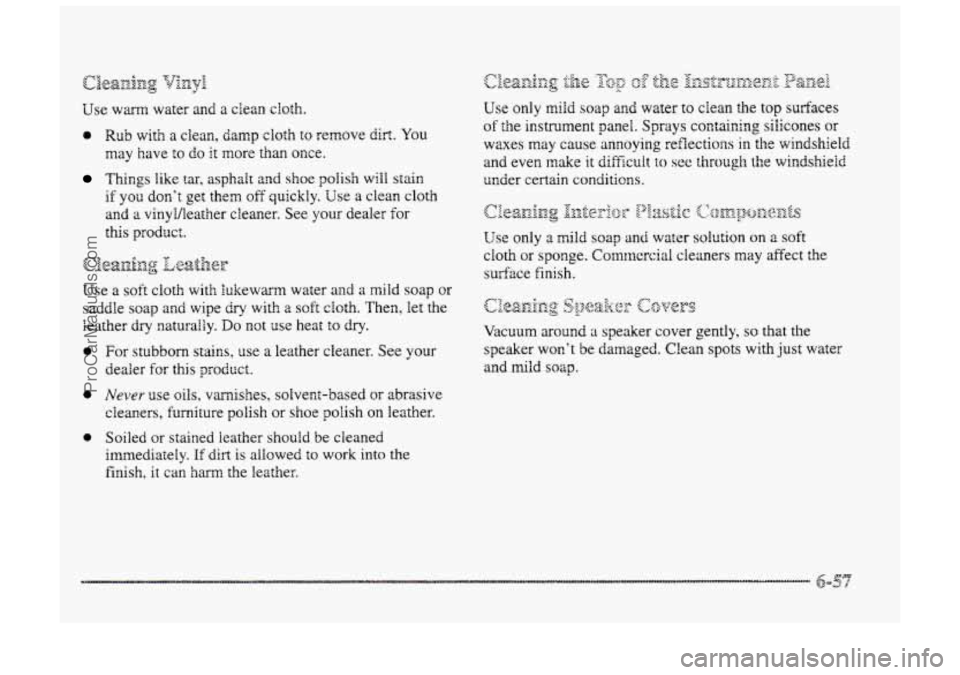
Use warm water and a clean cloth.
@ Rub with a clean, damp cloth to remove dirt. You
may have to do it more than once.
Things Hike tar, asphalt and shoe polish will stain
if you don't get them off quickly. Use a clean cloth
and a vinylAeather cleaner. See
pur dealer for
this produce.
Use
a so€t cloth with lukewarm water and a mild soap or
saddle soap and wipe dry with a soft cloth. Then, let the
leather
dry naturally. Do not me heat to dry.
e For stubborn stains, use a leather cleaner. See your
dealer for
this product.
0 Never rnse oils, varaishes, solvent-based or abrasive
cleaners, furniture
polish or shoe polish on leather.
0 Soiled or stained leather S~QUM be cleaned
immediately.
If dirt is allowed to work into the
finish. it can harm the leather. Vacuum
around a speaker
cover gently, so that the
speaker
won't be damaged. Clean spots with just water
and miid soap.
ProCarManuals.com
Page 332 of 426
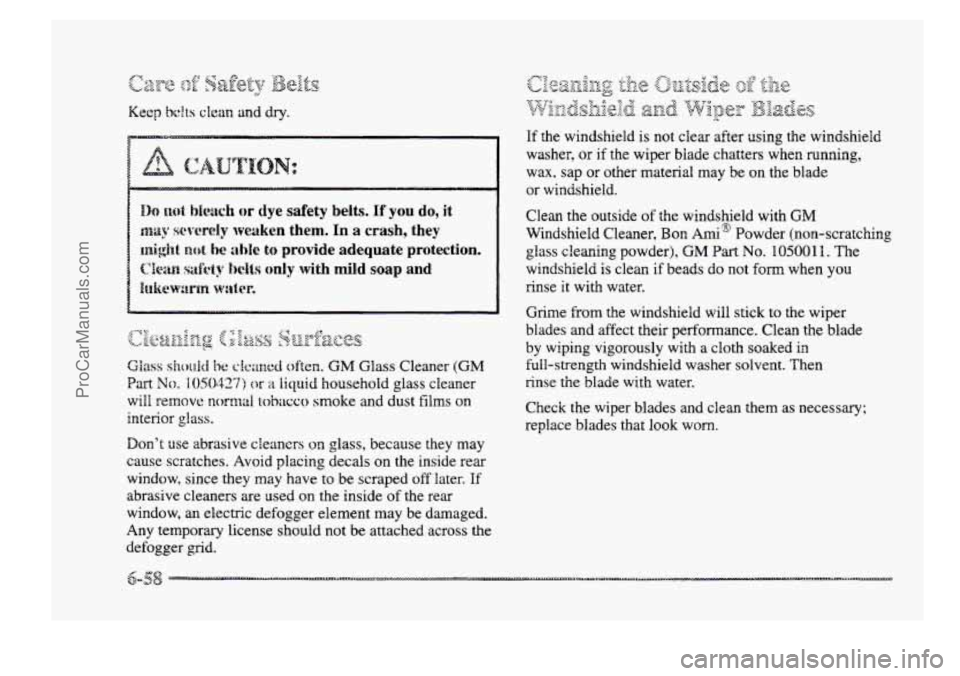
f-7 &kgL& I9 TQ :.. fl.<: >&7;L&T' '2 m -B&t.:
u
Keep kclts clem and dry.
might not he dole to provide adequate protection.
Ckrn safety helis only with mild soap and
lukewarm wttter.
fiTY4"cx<.. t.,LGaL&p tz&gs &%* ~,u&k-*,pq
k ". -- u, i-.
Glass sirodd be clculcd o.Aen. GM Glass Cleaner (GM
Part No. 1050427) or a Liquid household glass cleaner
will
remove tzosrnal tobucco smoke and dust films on
interior glass.
Don't use abrasive cleuners on glass, because they may
cause scratches. Avoid placing decals on the inside rear
window, since they
may have to be scraped off later. If
abrasive cleaners are used on the inside of the rear
window, an electric defogger element may
be damaged.
Any temporary license should not be attached across
the
defogger grid.
If the windshield is not clear after using the windshield
washer, or if the wiper blade chatters when running,
wax,
sap or other materid may be on the blade
or windshield.
Clean the outside
of the windshield with GM
Windshield Cleaner, Bon AmiB Powder (non-scratching
glass cleaning powder),
GM Bart No. 10500 1 I. The
windshield
is clean if beads do not form when you
rinse it with water.
Grime
from the windshield will stick to the wiper
blades and affect their performance. Clean the blade
by wiping vigorously with
a cloth soaked in
full-strength windshield washer solvent. Then
rinse the blade with water.
Check
the wiper blades and clean them as necessary;
replace blades that
look worn.
ProCarManuals.com
Page 333 of 426
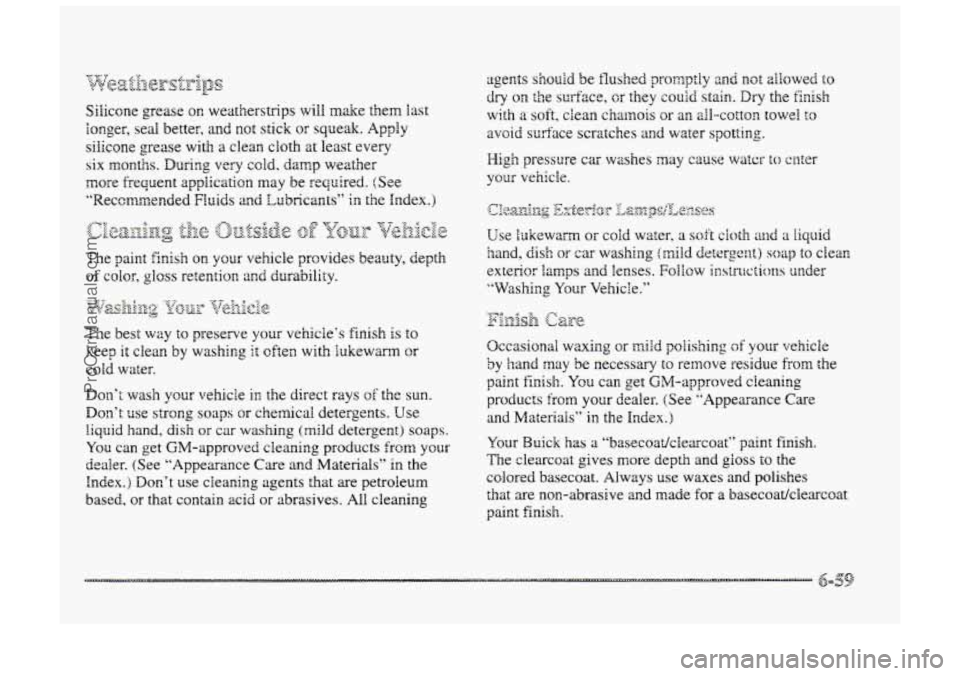
Silicone grease on weatherstrips will make them last
longer, seal better, and not stick or squeak. Apply
silicone grease with a clean cloth
at least every
six m~ntias. During very cold, damp weather
more frequent application may be required. (See
“Reccmmended Fluids
and %ubricants” in the Index.)
The paint
finish on your vehicle provides beauty, depth
of color, gloss retention 2nd durability.
The best
way to preserve your vehicle’s finish is to
keep it dean by washing it sften with Imkewm cr
cold water.
Dor~’: wash your vehicle in the direct rays of the sun.
hn’t use strong soaps or chemical detergents. Use
liquid hand, dish cx car washing (mild detergent) soaps.
You can get GM-approved cleaning products from your
dealer. (See “Appearance Care
and Materials” in the
Index.) Don’t use cleaning agents that are petroleum
based, or
that contain acid or abrasives. ALE cleaning
agents shoer%d be ilushed promptly 2nd not ahwed to
dry on the surface, or they couid stain. Dry the finish
with
a soft, clean chamois or an AI-cotton towel to
avoid surface scratches and water spotting.
High pressure car washes may cause water to enter
your vehicle.
OccasicsnaI waxing or mild polishing of your vehicle
by hand may be necessary to remove residue from the
paint finish. You can get GtM-approved cleaning
products from
your dealer. (See “Appearance Care
and Materiais”
in the Index.)
Your Buick has a “basecoat/cEearcoat” paint finish.
The clearcoat gives more depth and gloss to the
colored basecoat. Always use waxes
and polishes
that are non-abrasive and made
for a basecoatklearcoat
paint finish.
ProCarManuals.com
Page 334 of 426
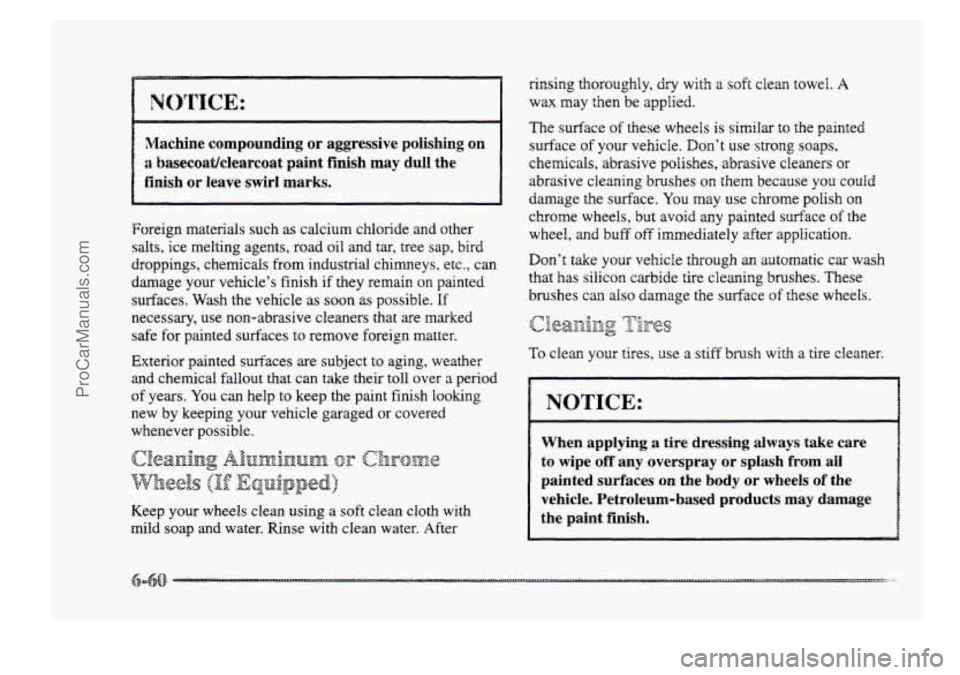
1 I rinsing thoroughly, dry with a soft dean towel. A
I NOTICE:
-
I wax may then be appied.
-I
The surface of these wheels is similar to the painted
Machine compounding or aggressive polishing on
abrasive cleaning brushes OR them because you could finish or leave swirl marks.
chemicals, abrasive polishes, abrasive cleaners or a basecoatklearcoat paint finish may dull the
surface of your vehicie. Don’t use strong soaps,
damage the surface.
You may use chrome polish on
chrome wheels, but avoid any painted surface
of the
Foreign materials such as calcium chloride and other wheel,
and buff off immediately after application.
salts, ice melting agents, road oil and tar, tree sap, bird
droppings, chemicals from industrial chimneys, etc., can
Don’t take your vehicle through an automatic car wash
damage your vehicle’s finish
if they remain on painted that has silicon carbide tire cleaning brushes. These
surfaces. Wash the vehicle as soon
as possible. If brushes can also damage the surface of these wheels.
necessary, use non-abrasive cleaners ihat
are marked
safe for painted surfaces
to remove foreign matter.
Exterior painted surfaces
are subject to aging, weather To clean your tires, use a stiff brush with a tire cleaner.
and chemical fallout that can take their toll over
a period I
of years. You can help to keep the paint finish looking
new by keeping your vehicle garaged or covered
whenever possible.
Keep your wheels clean using a soft clean cloth with
mild soap and water. Rinse with clean water. After I NOTICE:
When applying a tire dressing always take care
to wipe off any overspray or splash from all
painted surfaces
on the body or wheels of the
vehicle. Petroleum-based products
may damage
the paint finish.
ProCarManuals.com
Page 335 of 426
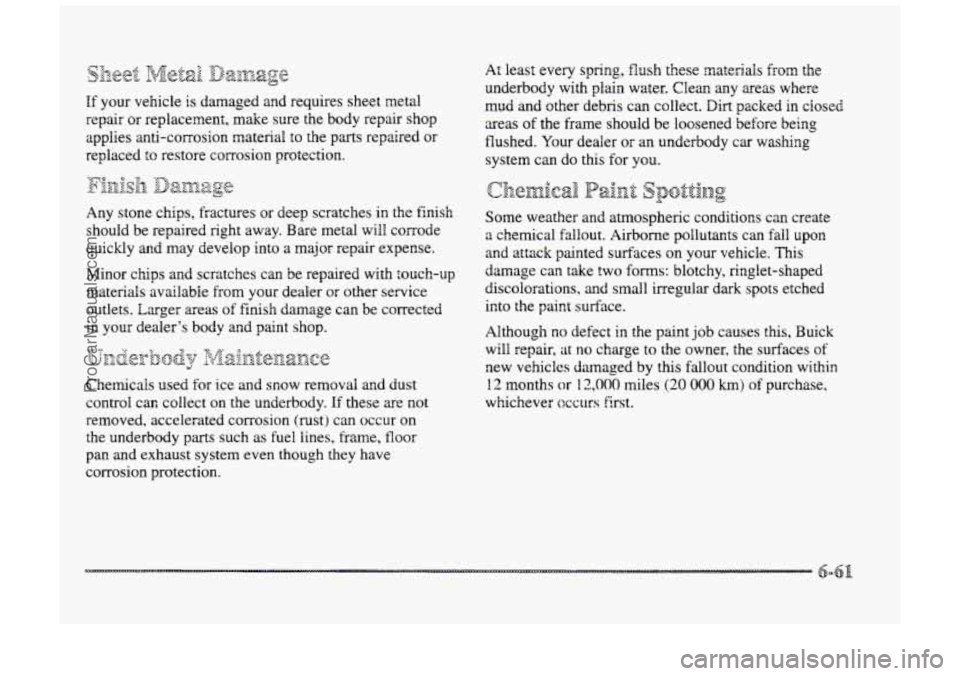
If your vehicle is damaged and requires sheet metal
repair
or replacement, make sure the body repair shop
applies anti-corrosion material
to the parts repaired or
replaced to restore corrosion protection.
Any stone
chips, fractures or deep scratches in the finish
should be repaired right away. Bare metal will corrode
quickly and may develop into
a major repair expense.
Minor
chips and scratches can be repaired with IOUCR-UP
materials available from your dealer or other service
outlets. Larger areas
of finish damage can be corrected
in
your dealer's body and paint shop.
Chemicals used €or ice and snow removal and dust
control can collect on the underbody.
If these are not
removed, accelerated corrosion
(rustj can occur on
the underbody
parts such as fuel lines, frame, floor
pan and exhaust system even though they have
corrosion protection. At least
every
spring, Rush these materials from the
underbody with plain water. Clean any areas where
mud and other debris can collect. Dirt packed in ciosed
areas of the frame should be loosened before being
flushed. Your dealer
or an underbody car washing
system can do this for you.
Some weather and atmospheric conditions can create
a chemical fallout. Airborne pollutants can fail upon
and attxk painted surfaces on your vehicle. This
damage can take two forms: blotchy, ringlet-shaped
discolorations,
and small irregular dark spots etched
into the paint surface.
Although
no defect in the paint job causes this, Buick
will repair,
at no charge to the owner, the surfaces of
new vehicles damaged by this fallout condition within
I2 months or 12,000 miles (20 000 km) of ourchase,
whichever
CCCU~S first.
ProCarManuals.com
Page 336 of 426
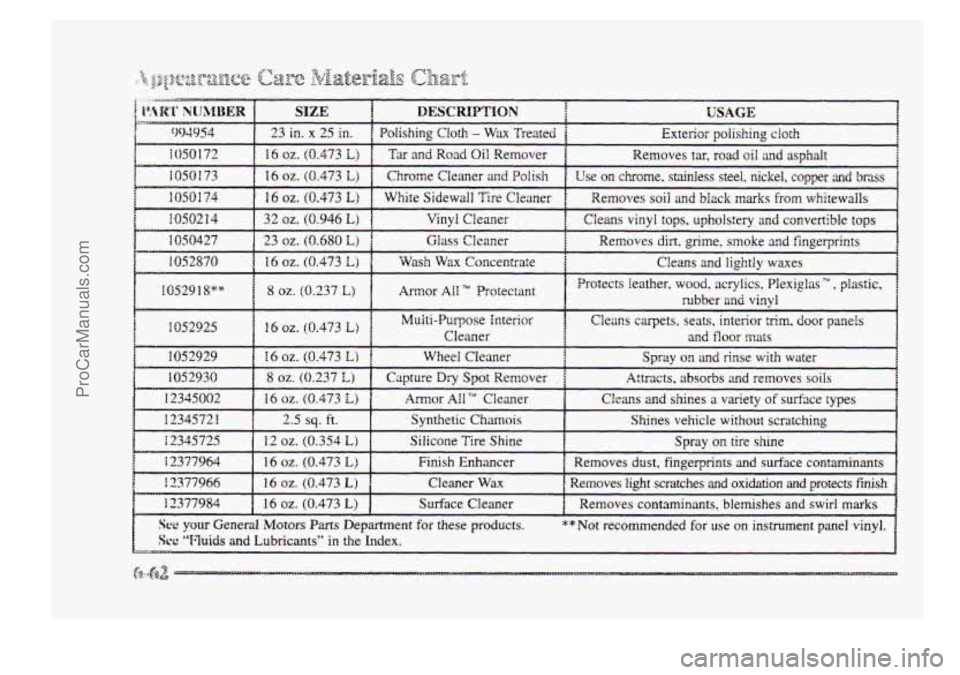
1 1052918"" 1 8 02. (0.237 L) I
Protects ieather, wood, acrylics, Plexiglas w, plastic,
mbber
and vinvl
1 1052925 f Cleaner and floor mats
Multi-Purpose interior C1em.s carpets, seats, interior trim. door panels
ProCarManuals.com
Page 337 of 426
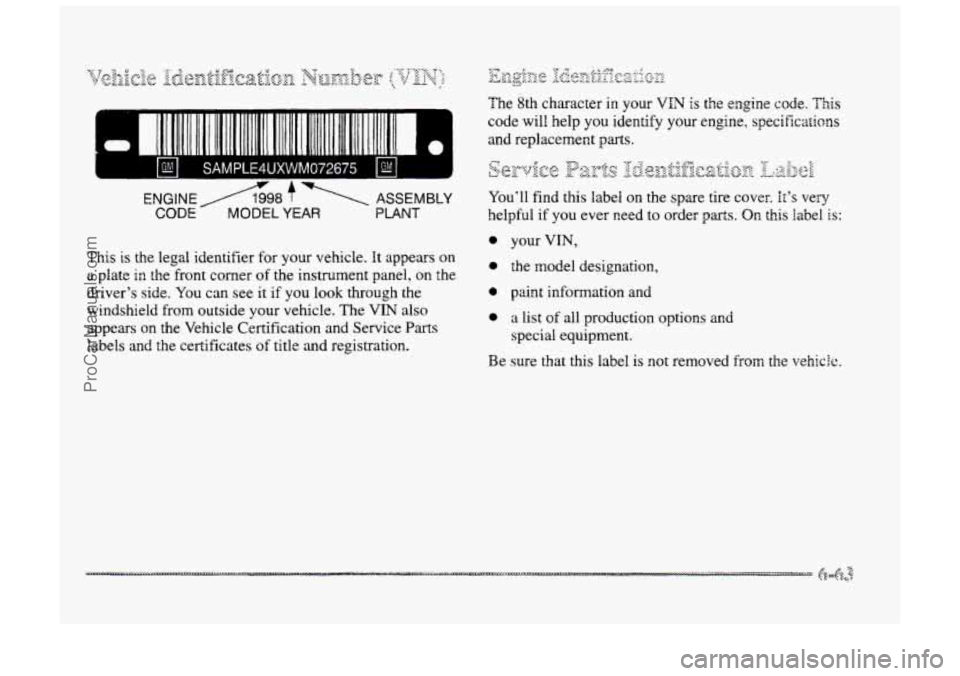
I U 1 SAMPLE4UXWM072675 I E! I I
ENGINE A98 f 1 ASSEMBLY
CbDE A MODEL YEAR PLANT
This is the legal identifier for your vehicle. It appears on
a plate in the front comer of the instrument panel, on the
driver's side. You can
see it if you look through the
windshield from outside your vehicle. The VIN
also
appears on the Vehicle Certification and Service Parts
labels and the certificates of title and registration.
Be sure that this label is
not removed from the vek-rlc?~.
ProCarManuals.com
Page 338 of 426
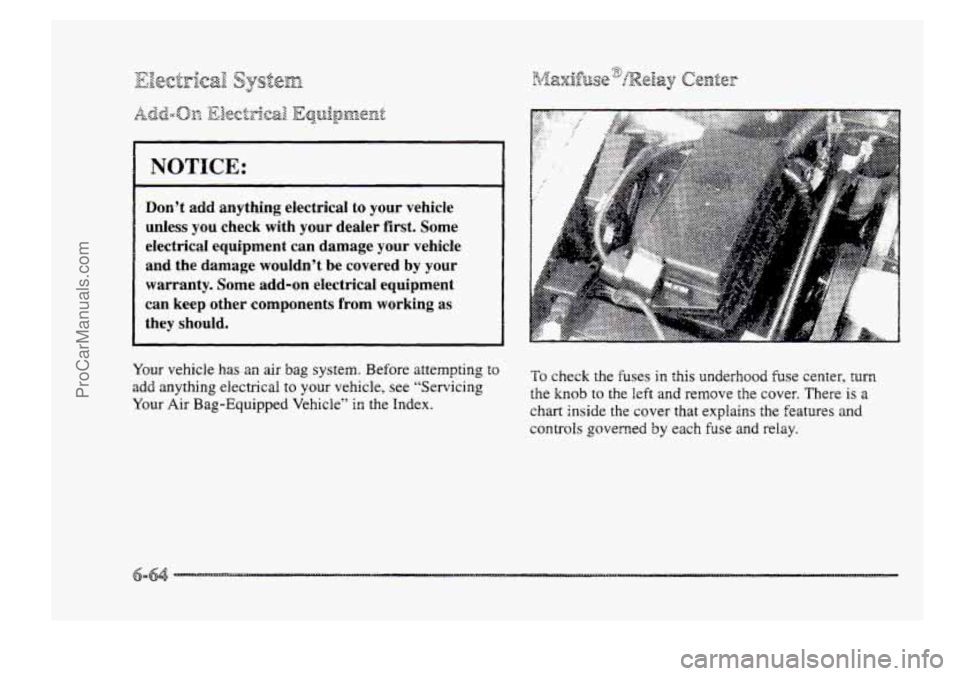
NOTICE:
Don’t add anything electrical to your vehicle
unless you check with your dealer first. Some
electrical equipment can damage your vehicle
and the damage wouldn’t be covered by your
warranty. Some add-on electrical equipment
can keep other components
from working as
they should.
Your vehicle has an air bag system. Before attempting to
add anything electrical to your vehicle, see “Servicing
Your Air Bag-Equipped Vehicle” in the Index.
To check ;he fuses in this underhood fuse center, mrn
the knob to the left and remove the cover. There is a
chart inside the cover that explains the features and
controls governed by each fuse and relay.
ProCarManuals.com
Page 339 of 426
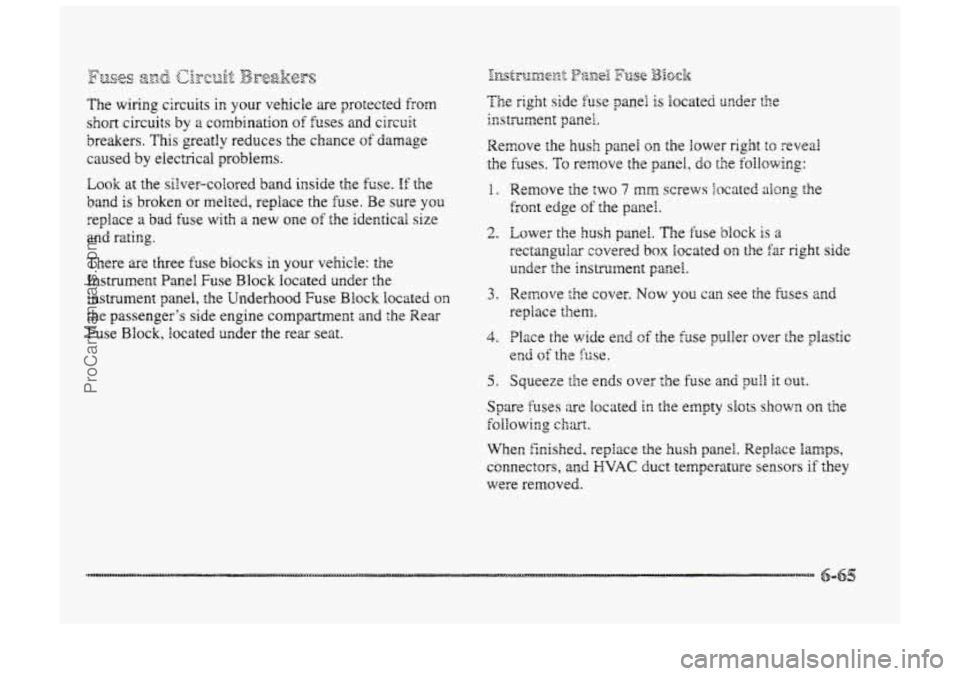
The wiring circuits in your vehicle are potected from
short circuits by a combination of fuses and circuit
breakers. This greatly reduces ?;he chance
of damage
caused
by electrical problems.
Look at the silver-cobred band inside the fuse. If the
band is broken or melted, replace the fuse. Be sure
you
replace a bad fuse with a new one of the identical size
and rating.
Tlere
are three fase blocks in your vehicle: the
Instrument
Pace1 Fuse Block located under the
instrument panel, the Underhood Fuse Block located
QTP
the passenger's side engine compartment and the Xear
Fuse Block, located under the rear seat.
I.
2.
3.
4.
5.
Remove the two 7 mm screws located aIsng the
front edge of the panel.
Lower the
hush panel. The fuse block is a
rectangular covered box iocated on the far right side
under the instrument panel.
Remove the cover. Now you can see the hses 2nd
replace them.
Place the wide
end of the he puller over the plastic
end of the f;crse.
Squeeze the ends over the fuse and pull it out.
Spare fuses are located in the enpty slots shown OR the
foliowing chat.
When finished, repiace the hush panei. Replace lamps,
connectors,
and HVAC duct temperature sensors if they
were removed.
ProCarManuals.com
Page 340 of 426
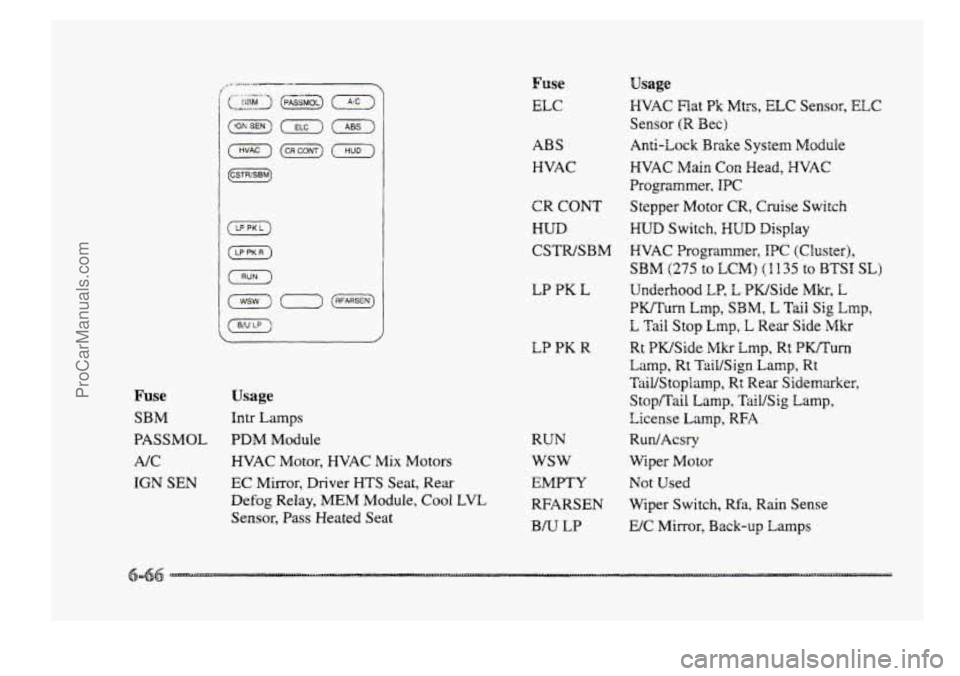
(G) I
Fuse Usage
SBM Intr Lamps
PASSMOL PDM Module
NC HVAC Motor, HVAC Mix Motors
IGN SEN EC Mirror, Driver HTS Seat, Rear
Defog Relay, MEM Module,
Cool LVL
Sensor, Pass Heated Seat
Fuse
ELC
ABS
HVAC
CR CON"
HUD
CSTWSBM
LB PK E
LP PK R
RUN
wsw
EMPTY
RFARSEN
B/U LP
Usage
HVAC Rat Bk Mtrs, EkC Sensor, EEC
Sensor (R Bec)
Anti-Lock Brake System Moduie
KVAC
Main Con Head, HVAC
Programmer, HPC
Stepper Motor CR, Cruise Switch
HUD Switch, HUD DispIay
WVAC i'rograrnrner, IPC (Cluster),
Underhood LP, L PUSide Mk, L
PK/Turn Lmp, SBM, L Tail Sig Lmp,
L Tail Stop Lmp, L Rear Side Mks
Rt PWSide Mkr imp, Rt PwTFurn
Lamp, Wt TaiUSign Lamp, Rt
TaiUStoplarnp, R: Rear Sidemarker,
Stopflail Lamp, Tail/Sig Lamp,
License Lamp, RFA
Run/Acsry
Wiper Motor
Not Used
Wiper Switch,
Wa, Rain Sense
E/C Minor, Back-up
Lamps
SBM (275 to LCM) (1 135 to BTSH SL)
ProCarManuals.com